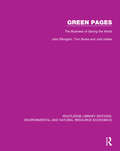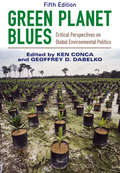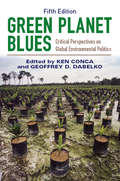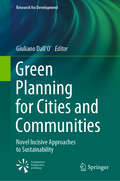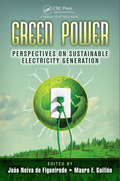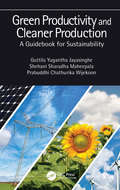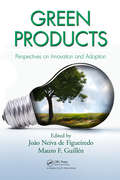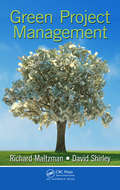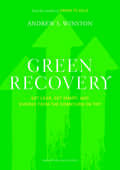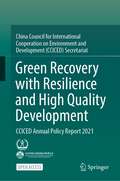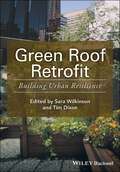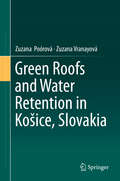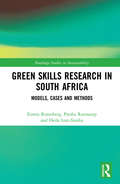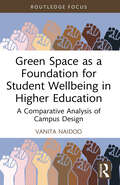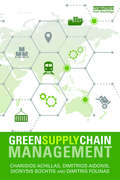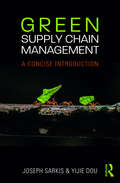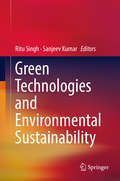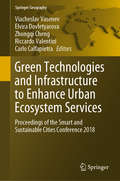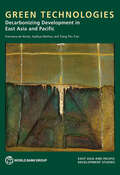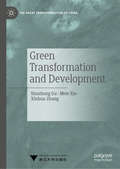- Table View
- List View
Green Pages: The Business of Saving the World (Routledge Library Editions: Environmental and Natural Resource Economics)
by John Elkington Tom Burke Julia HailesOriginally published in 1988. Europeans want a better environment. Increasingly, too, they are demanding the products, services, legislation and policies that will provide it. Green Pages reveals what Europe’s environmentalists plan to do next and how environmental pressures will threaten major markets – and at the same time opens up new opportunities for business, investment and employment. Green Pages is a fantastic reference source for green enterprise, and will be of interest to students of environmental economics.
Green Planet Blues
by Geoffrey D. Dabelko Edited by Ken ConcaRevised and updated throughout, this unique anthology examines global environmental politics from a range of perspectives#151;contemporary and classic, activist and scholarly#151;and reflects voices of the powerless and powerful. Paradigms of sustainability, environmental security, and ecological justice illustrate the many ways environmental problems and their solutions are framed in contemporary international debates about climate, water, forests, toxics, energy, food, biodiversity, and other environmental challenges of the twenty-first century. Organized thematically, the selections offer a truly global scope. Seventeen new readings discuss climate justice, environmental peacebuilding, globalization, land grabs, corporate environmentalism, climate adaptation, gender, disaster risk, resilience, and the future of global environmental politics in the wake of the #147;Rio+20” global summit of 2012. This book stresses the underlying questions of power, interests, authority, and legitimacy that shape environmental debates, and it provides readers with a global range of perspectives on the critical challenges facing the planet and its people.
Green Planet Blues
by Geoffrey D. Dabelko Edited by Ken ConcaRevised and updated throughout, this unique anthology examines global environmental politics from a range of perspectives#151;contemporary and classic, activist and scholarly#151;and reflects voices of the powerless and powerful. Paradigms of sustainability, environmental security, and ecological justice illustrate the many ways environmental problems and their solutions are framed in contemporary international debates about climate, water, forests, toxics, energy, food, biodiversity, and other environmental challenges of the twenty-first century. Organized thematically, the selections offer a truly global scope. Seventeen new readings discuss climate justice, environmental peacebuilding, globalization, land grabs, corporate environmentalism, climate adaptation, gender, disaster risk, resilience, and the future of global environmental politics in the wake of the #147;Rio+20” global summit of 2012. This book stresses the underlying questions of power, interests, authority, and legitimacy that shape environmental debates, and it provides readers with a global range of perspectives on the critical challenges facing the planet and its people.
Green Planet Blues: Critical Perspectives on Global Environmental Politics (5th Edition)
by Ken Conca Geoffrey D. Dabelko<p>Revised and updated throughout, this unique anthology examines global environmental politics from a range of perspectives (contemporary and classic, activist and scholarly) and reflects voices of the powerless and powerful. Paradigms of sustainability, environmental security, and ecological justice illustrate the many ways environmental problems and their solutions are framed in contemporary international debates about climate, water, forests, toxics, energy, food, biodiversity, and other environmental challenges of the twenty-first century. Organized thematically, the selections offer a truly global scope. Seventeen new readings discuss climate justice, environmental peacebuilding, globalization, land grabs, corporate environmentalism, climate adaptation, gender, disaster risk, resilience, and the future of global environmental politics in the wake of the 'Rio+20' global summit of 2012. <p>This book stresses the underlying questions of power, interests, authority, and legitimacy that shape environmental debates, and it provides readers with a global range of perspectives on the critical challenges facing the planet and its people.</p>
Green Planning for Cities and Communities: Novel Incisive Approaches to Sustainability (Research for Development)
by Giuliano Dall’O’This book addresses key issues across the field of sustainable urban planning, and provides a unique reference tool for planners, engineers, architects, public administrators, and other experts. The evolution of cities and communities is giving rise to pressing energy and environmental problems that demand concrete solutions. In this context, urban planning is inevitably a complex activity that requires a sound analytical interpretation of ongoing developments, multidisciplinary analysis of the available tools and technologies, appropriate political management, and the ability to monitor progress objectively in order to verify the effectiveness of the policies implemented. This book is exceptional in both the breadth of its coverage and its focus on the interactions between different elements. Individual sections focus on strategies and tools for green planning, energy efficiency and sustainability in city planning, sustainable mobility, rating systems, and the smart city approach to improving urban-scale sustainability. The authors draw on their extensive practical experience to provide operational content supplementing the theoretical and methodological elements covered in the text, and each section features informative case studies.
Green Power: Perspectives on Sustainable Electricity Generation
by Mauro F. Guillén João Neiva de FigueiredoGreen Power: Perspectives on Sustainable Electricity Generation provides a systematic overview of the current state of green power and renewable electrical energy production in the world. Presenting eight in-depth case studies of green power production and dissemination, it illustrates the experiences and best practices of various countries on this
Green Productivity and Cleaner Production: A Guidebook for Sustainability
by Guttila Yugantha Jayasinghe Shehani Sharadha Maheepala Prabuddhi Chathurika WijekoonGreen Productivity and Cleaner Production: A Guidebook for Sustainability focuses on green production processes that could help better achieve global sustainability. It aids readers in realizing the issues with current conventional productivity initiatives and examines the newest methods. Also, it presents numerous real-world applications techniques, which allows users the ability to apply the most appropriate solutions for their situations. Further, it explains measures to achieve green productivity and cleaner production to help maintain high quality, sustainable production chains while simultaneously conserving natural resources and reducing waste. Features: Examines the core theories and techniques for green productivity, waste management, end-of-pipe treatment methods, sustainable production technologies, and cleaner production Written with a simple and easily understandable presentation, applicable for both undergraduate students and practicing professionals alike Provides guidance on how to use different tools and techniques in various problem-solving scenarios Focuses on greening production processes as an initiation to achieve global environmental sustainability Includes numerous illustrations, along with practical examples and tools helpful for readers to understand and apply the approaches presented throughout The subjects covered in Green Productivity and Cleaner Production: A Guidebook for Sustainability are of interest to students, researchers, academicians, and professionals in various industries.
Green Products: Perspectives on Innovation and Adoption
by Mauro F. Guillén João Neiva de FigueiredoSharing successful examples of sustainable products from around the world, Green Products: Perspectives on Innovation and Adoption supplies an in-depth analysis of the key factors that influence the adoption of sustainable products. It examines case studies of green production and consumption from a business perspective considering both techno
Green Project Management
by David Shirley Richard MaltzmanWinner of PMI's 2011 David I. Cleland Project Management Literature AwardDetailing cutting-edge green techniques and methods, this book teaches project managers how to maximize resources and get the most out of limited budgets. It supplies proven techniques and best practices in green project management, including risk and opportunity assessments.
Green Recovery
by Andrew S. WinstonWhen the economy turns rough, many companies sideline their green business initiatives. That's a big mistake. In Green Recovery, Andrew Winston shows that no company can afford to wait for the downturn to ease before going green.Green initiatives ratchet up your company's resource efficiency, creativity, and employee motivation. They save energy, waste, and money, preserving precious capital-and give precise focus to your innovation efforts and strategic priorities.Part manifesto and part how-to guide, this concise and engaging book provides a road map for using green initiatives to deliver short-term gains and position your company for long-term strategic growth. You'll discover how to:-Get lean: Amp up your energy and resource efficiency to survive tough times-Get smart: Use environmental data about products and supply chains for competitive advantage-Get creative: Rejuvenate your innovation efforts by asking heretical questions such as "How might we operate with no fossil fuels?"-Get going: Engage and excite employees to solve the company's, the customer's, and the world's environmental challengesGreen Recovery is your guide to establishing your competitive positioning in difficult times and emerging even stronger into a vastly changed economy.
Green Recovery with Resilience and High Quality Development: CCICED Annual Policy Report 2021
by CCICEDThis open access book is based on the research outputs of China Council for International Cooperation on Environment and Development (CCICED) in 2021. It covers major topics of Chinese and international attention regarding green development, such as climate, biodiversity, ocean, BRI, urbanization, sustainable production and consumption, technology, finance, value chain, and related topics. It also reviews the progress of China‘s environmental and development policies and the impacts from CCICED. This is a highly informative and carefully presented book, providing insight for policy makers in environmental issues.
Green Remodeling
by David R. Johnston Kim MasterWhether because of changing lifestyles or simply because houses are becoming outdated, millions of North Americans are renovating their homes every year, spending more money annually on renovation than on new-home construction. But renovations can be fraught with unintended consequences like indoor air pollution. How do you remodel in a healthy, environmentally friendly way?Green Remodeling is a comprehensive guide. It first points out the advantages of remodeling. Buildings are responsible for 40% of worldwide energy flow and material use; so how you remodel can make a difference. Upgrading furnaces, cabinets and toilets means less fossil fuel pollution, reduced resource depletion and fewer health risks. Green remodeling is more energy-efficient, more resource-conserving, healthier for occupants and creates buildings that are more affordable to build, operate and maintain.The book then discusses simple green renovation solutions for homeowners, focusing on key aspects of the building, including foundations, framing, plumbing, windows, heating and finishes. Room by room, it outlines the intricate connections that make the house work as a system. For example, how new windows may affect the structure and mechanical systems of the rooms below, the health of the family and the future of old-growth forests. Then, in an easy-to-read format complete with checklists, personal stories, expert insights and an extensive resource list, it covers easy ways to save energy, conserve natural resources and protect the health of loved ones. Addressing all climates, this is a perfect resource for conventional homeowners, as well as for architects and remodeling contractors.David Johnston was named one of the top 50 remodelers in the U.S. in 1990. He developed the first green remodeling program in the U.S. and is creating a national green certification program for the National Association of the Remodeling Industry. Kim Master is a green building consultant. Both are from Boulder, Colorado.
Green Roof Retrofit: Building Urban Resilience
by Sara J. Wilkinson Tim DixonA deep understanding of the implications of green roof retrofit is required amongst students and practitioners to make the decisions and take the actions needed to mitigate climate changes. Green Roof Retrofit: building urban resilience illustrates the processes undertaken to develop this new knowledge and thereby embed a deeper level of understanding in readers.Illustrative case studies and exemplars are drawn from countries outside of the core researched areas to demonstrate the application of the knowledge more broadly. Examples are used from the Americas (North and South and Canada), Oceania, Asia and other European countries.The book describes the multiple criteria which inform decision making and how this provides a way forward for making better decisions about green roof retrofit in different countries and climates.
Green Roofs and Water Retention in Košice, Slovakia
by Zuzana Poórová Zuzana VranayováThis book discusses how climate change and heat islands are a main contributor to water related problems in urban areas in Košice, Slovakia. Green roofs are used as a tool to assist in solving these water related issues. The need to provide housing in urban areas is expected to rise to 66% in 2050, according to the United Nations. Many urban areas have seen natural permeable green areas replaced with concrete constructions and hard, non-permeable surfaces. The densification of existing built-up areas is responsible for the decreasing vegetation, which results in the lack of evapotranspiration cooling the air, thereby creating urban heat islands. Several studies, discussed in this book, have shown that natural and permeable surfaces, as in the case of green roofs, can play a crucial role in mitigating this negative climate phenomenon and providing higher efficiency for buildings, leading to savings such as water, one of the focal points of this research.
Green Scenarios: International Mining Forum 2021
by Artur DyczkoThis book aims to present an alternative based on natural processes and an environmental approach to post-excavation site management, e.g., post-coal mining heaps. These sites are places where various mineral excavation by-products are collected. Nevertheless, some post-mineral excavation sites are oligotrophic, terrestrial, wetland, and water habitat islands, providing unique biodiversity enrichment in the landscape. These oligotrophic mineral habitats are essential in over-fertilized, eutrophic, agricultural and urban-industry surroundings. Some post-mineral excavation sites are places where the wildlife can develop and support the functional processes of novel ecosystems. Implementing the newest biogeochemical and comprehensive knowledge into urban-industry landscape management will help to establish the ecosystem’s processes and environmental functioning.There are several post-industrial sites in Europe where the wildlife areas developed due to natural processes, are becoming wildlife hotspots in densely populated urban-industry areas. In this respect, many of the oligotrophic mineral terrestrial, wetland, and water habitats of anthropogenic origin should not be categorized as environmentally dangerous and undergo economic utility-focused reclamation.Facing the actual environmental constraints of the Anthropocene Epoch, the book’s chapters presenting the natural basics and perquisites of the environmental ecosystem mosaics, will be interesting for a broad range of environmentalists (scientists and students), miners, economists, and sociologists.
Green Science and Technology
by Enoch Y. Park Takayuki Saito Hirokazu Kawagishi Masakazu HaraThis book provides a comprehensive and up-to-date review of recent trends of green science and technology. Worldwide deterioration of environment and global warming threaten our lifestyle and the survival of all creatures. In order to weather these problems, we need to construct a multidisciplinary approach involving the fusion of various advanced researches. The book begins with an overview on fundamental research about generation and utilization of renewable energy, protection of the earth's ecosystem for better coexistence with nature, development of artificial intelligence-based agriculture and molecular recognitionbased welfare and covers a wide range of innovative research on green science and technology.
Green Skills Research in South Africa: Models, Cases and Methods (Routledge Studies in Sustainability)
by Heila Lotz-Sisitka Eureta Rosenberg Presha RamsarupThis book proposes transformative, realist methodology for skills research and planning through an analysis of case studies of the changing world of work, new learning pathways and educational system challenges. Studies of the green economy and sustainability transitions are a growing field internationally, however there are few books that link this interest to the development of skills. This book draws on, and showcases, the experience and insights of researcher-practitioners who are at the cutting edge in this emerging field, internationally and in South Africa. The context for this book is South Africa, but application is worldwide. In many ways indicative of the global picture, South Africa is in the grip of economic and environmental imperatives, searching for safe and just transitions. The authors present a new, embedded transitioning systems model for studying skills for a sustainable, just future. This book will be of great interest to students and scholars of sustainable development, ecological economics and skills planning.
Green Space as a Foundation for Student Wellbeing in Higher Education: A Comparative Analysis of Campus Design (Routledge Research in Higher Education)
by Vanita NaidooThis book presents a unique comparative case study that details the narrative around campus design at the first institutions of public higher education in the United States. With a focus on Southern design at the turn of the 18th century, it explores the use and perception of campus green space and its influence on student wellbeing and belonging, using both structural and lived perspectives.With attention to the post-COVID-19 context, the comparative analysis of two campuses, The University of North Carolina (UNC) at Chapel Hill and the University of Georgia, offers insight into how historical context, location, and design all influence the use of space. The case studies and analysis also serve as examples of how institutions and university systems hoping to engage with design practices can promote positive learning environments that are both inclusive and supportive. Each chapter addresses an experiential aspect of space, linking back to the dialogue on diversity, inclusion, and identity. In addition to considerations around diversity, the book also offers a rich narrative that uncovers the links between American Education and the New Southern Republic, shining a light on the role of place, historical origin, and socio-political circumstances in shaping campus design.A superb resource for scholars and postgraduates studying higher education, environmental psychology, and urban planning, it chronicles the evolution of campus design at public institutions of higher education from a unique historical perspective.
Green Supply Chain Management
by Dimitrios Aidonis Dimitris Folinas Charisios Achillas Dionysis D. BochtisToday, one of the top priorities of an organization’s modern corporate strategy is to portray itself as socially responsible and environmentally sustainable. As a focal point of sustainability initiatives, green supply chain management has emerged as a key strategy that can provide competitive advantages with significant parallel gains for company profitability. In designing a green supply chain, the intent is the adoption of comprehensive and cross-business sustainability principles, from the product conception stage to the end-of-life stage. In this context, green initiatives relate to tangible and intangible corporate benefits. Sustainability reports from numerous companies reveal that greening their supply chains has helped reduce operating cost, thus boosting effectiveness and efficiency while increasing sustainability of the business. Green Supply Chain Management provides a strategic overview of sustainable supply chain management, shedding light on the theoretical background and key principles of the topic. Specifically, this book covers various thematic areas including benefits and impact of green supply chain management; enablers and barriers on supply chain operations; inbound and outbound logistics considerations; and production, packaging and reverse logistics under the notion of "greening". The ultimate aim of this textbook is to highlight the challenges in the implementation of green supply chain management in modern companies and to provide a roadmap for decision-making in real-life cases. Combining chapter summaries and discussion questions, this book provides an accessible and student-friendly introduction to green supply change management and will be of great interest to students, scholars and practitioners in the fields of sustainable business and supply chain management.
Green Supply Chain Management: A Concise Introduction
by Joseph Sarkis Yijie DouThis book gives students a thorough overview of the environmental issues that impact the supply chain and details strategic methods of addressing the political, social, technological, market, and economic concerns that have caused organizations to reconsider their impact. Readers will learn how to integrate the fields of operations management, procurement and purchasing, logistics, and marketing into a successful green supply chain, looking outward to form sustainable partnerships rather than focusing their efforts within the company. Each chapter describes a function or dimension of green supply chains, supplemented with short vignettes to ground the theory in practice. The authors examine various industries, including electronics, food products, and manufacturing, and draw on case studies from the Americas, Europe, Asia, and Oceania, allowing students to compare and contrast domestic and international practices. Blending industry insights with the latest academic thinking, they also consider hot button topics like global–local relationships, the role of third parties, green multitier supplier management, and blockchain technology management. Conclusive chapter summaries and plenty of visual aids help readers retain the information they need to improve environmental performance within, and beyond their organizations. Green Supply Chain Management is an excellent introduction to the topic for students and practitioners of supply chain management and environmental sustainability.
Green Technologies and Environmental Sustainability
by Sanjeev Kumar Ritu SinghIn the present scenario, green technologies are playing significant role in changing the course of nation's economic growth towards sustainability and providing an alternative socio-economic model that will enable present and future generations to live in a clean and healthy environment, in harmony with nature. Green technology, which is also known as clean technology, refers to the development and extension of processes, practices, and applications that improve or replace the existing technologies facilitating society to meet their own needs while substantially decreasing the impact of human on the planet, and reducing environmental risks and ecological scarcities. The concepts of Green Technologies, if endorsed and pervaded into the lives of all societies, will facilitate the aim of the Millennium Development Goals of keeping the environment intact and improve it for the civilization to survive. Green Technologies and Environmental Sustainability is focused on the goals of green technologies which are becoming increasingly important for ensuring sustainability. This book provides different perspectives of green technology in sectors like energy, agriculture, waste management and economics and contains recent advancements made towards sustainable development in the field of bioenergy, nanotechnology, green chemistry, bioremediation, degraded land reclamation. This book is written for a large and broad readership, including researchers, scientists, academicians and readers from diverse backgrounds across various fields such as nanotechnology, chemistry, agriculture, environmental science, water engineering, waste management and energy. It could also serve as a reference book for graduates and post-graduate students, faculties, environmentalist and industrial personnel who are working in the area of green technologies.
Green Technologies and Infrastructure to Enhance Urban Ecosystem Services: Proceedings of the Smart and Sustainable Cities Conference 2018 (Springer Geography)
by Riccardo Valentini Carlo Calfapietra Elvira Dovletyarova Viacheslav Vasenev Zhongqi ChengThese proceedings of the Smart and Sustainable Cities Conference (SSC) in Moscow from May 23 to 26, 2018 addresses important questions regarding the global trend of urbanization. What are the environmental consequences of megacities’ expansion? What smart solutions can make life in cities safe, comfortable and environmentally friendly? It is projected that 70% of the global population will live in cities by 2050, and as such the book describes how this rapid urbanization will alter the face of the world. Focusing on solutions for the environmental problems of modern megapolises, it discusses advanced approaches and smart technologies to monitor, model and assess the environmental consequences and risks. The contributors present examples of successful sustainable urban development, including management and design of green infrastructure, waste management, run-off purification and remediation of urban soils. The SSC conference and its proceedings offer a valuable contribution to sustainable urban development, and are of interest to the scientific and research community, municipal services, environmental protection agencies, landscape architects, civil engineers, policy makers and other stakeholders in urban management and greenery.
Green Technologies: Decarbonizing Development in East Asia and Pacific
by Aaditya Mattoo Trang Thu Tran Francesca de NicolaThe East Asia and Pacific region is helping the world decarbonize and is encouraging the domestic adoption of renewables. But there is an imbalance: while the region’s innovation and investment improve global access to green technologies, its own emissions continue to grow because of the reluctance to penalize carbon-intensive practices. The disparity between domestic supply and demand spills over into international trade, provoking measures by other countries that limit access to markets and technologies. Green Technologies: Decarbonizing Development in East Asia and Pacific argues that deeper reform of the region’s own policies will encourage the domestic diffusion of cleaner technologies and may also foster greater international cooperation—on climate as well as on innovation and trade in green goods. The book proposes a framework to guide policy on green technology development and diffusion. It will be of interest to policy makers, businesses, and researchers working at the intersection of economics and environmental policy.
Green This! Volume 1
by Deirdre ImusChange the way you clean and keep your family's home wholesome and healthy with the help of expert and activist Deirdre Imus. We all grew up thinking chemical smells like bleach and ammonia signaled "clean." But as Deirdre Imus reveals, some of the chemicals we use to maintain our homes are doing us and our families much more harm than good. In Greening Your Cleaning, the first in her Green This! series, Deirdre shows how cleaning house the environmentally responsible way can be as effective and often cheaper than the more traditional, toxic, means. This volume includes: Simple, efficient cleaning methods for every room of the house Spotlights on everyday products (all purpose cleaner, glass/window cleaner, laundry detergent) and the toxic ingredients you should be wary of Summaries of the latest research on the toxic effects of ordinary chemicals Resource lists of widely available "green cleaning" products and retailers Filled with tips and testimonials, Greening Your Cleaning will show you how to streamline your cleaning products and practices, and how easy it is to make "living green" your way of life.
Green Transformation and Development (The Great Transformation of China)
by Shuzhong Gu Meie Xie Xinhua ZhangThis book offers an insiders' view into Chinese plans for a green transformation of the economy of China. Analyzing the pressures, drive, and resistance to this green transformation in China, the book explores the key fields, from green finance and green banking to green consumption and green urbanization. Furthermore, it offers a guide on how government officials will be penalized or rewarded for their successful furtherance of green objectives. This book will be of interest to climate activists, China watchers, architects, and all those invested in a sustainable future.
